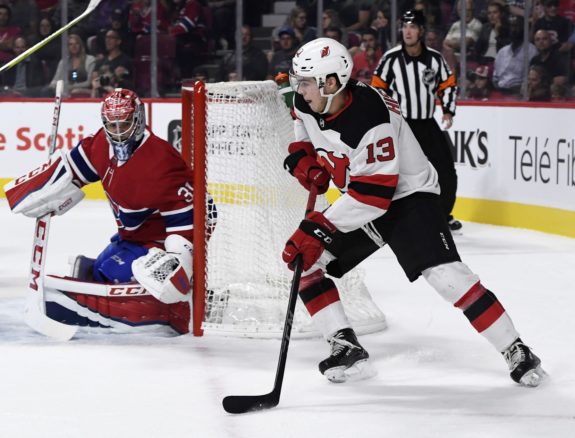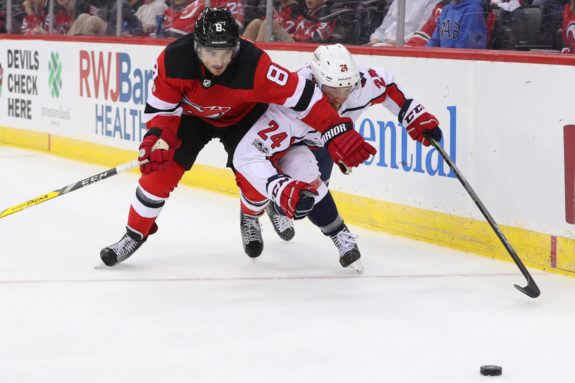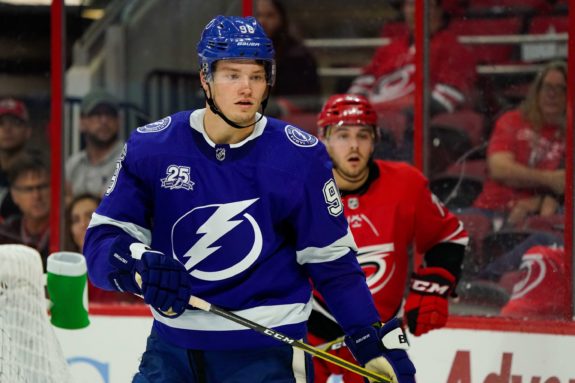Each year, the Calder Memorial Trophy is “given to the player selected as the most proficient in his first year of competition in the National Hockey League.” Traditionally awarded to the rookie forward with the most points with added consideration given to team success. In fact, out of the past ten Calder Trophy Awards dating back to the 2007-08 season, seven have gone to forwards and all of them led or tied for the league lead in rookie scoring with half of the winners playing on playoff teams. This season is likely to be no different than the previous ten given the success that Brock Boeser, Mathew Barzal, and Clayton Keller are having.
By the typical standards, the award is due to be given to Barzal or Boeser as both are at least at a point-per-game average. However, I want to determine who is actually most deserving of winning the trophy and not just give it to the rookie scoring leader. I feel that there are other factors to include than simply posting a high point total on a good team and that a player’s position, usage, and on-ice metrics should be factored in as well.
The Traditional Calder Candidates
Clayton Keller Leading the Pack in the Desert
Clayton Keller is succeeding in his first NHL season after having a stellar freshman season at Boston University in what was his only year of collegiate hockey. He is leading the Coyotes in both points and goals and is third in league rookie scoring with 20 points in 26 games. A natural center, Keller has played a majority of his ice time on the wing, creating an easier path to success for him early in his career but also limiting his on-ice impact.

Keller has been one of the few bright spots for the Coyotes in an otherwise bad season, with 8 of his 11 goals coming in 5-on-5 situations. He is the most impactful player for Arizona when on the ice, already generating 26 individual high danger scoring chances at 5-on-5, the most on the roster. The coaching staff clearly trusts him, giving him the second highest ice time (19:26) of Coyotes forwards, behind only Derek Stepan.
Unfortunately, the Coyotes have just a Fenwick For (FF) of 48.27%, a PDO of 96.3, and are controlling under 40% of goals scored in 5-on-5 play when he is on the ice. Keller will also be hindered by the team’s poor record and the unlikeliness that they make the playoffs this season.
Brock Boeser Anything but Lucky in Vancouver
Despite what Pittsburgh goaltender Matt Murray said following a November 22nd game against the Canucks, Brock Boeser has been anything but lucky in his rookie season. In that game, Boeser scored two goals against the Penguins in a follow-up to a game on November 4th when he netted a hat trick with Murray in net. These two games are solid indicators of Boeser’s rookie season so far as he leads the Canucks in every offensive category and is second in the NHL’s rookie scoring race but tied for the lead in rookie goals.
The idea that Vancouver is even in the hunt for a playoff spot is in large part due to Boeser’s emergence as a dangerous goalscorer. Perhaps the truest mark of his scoring ability is that he has netted eight of his goals at 5-on-5 and is shooting 20% in those situations. Boeser has also made the Canucks a better team when he is on the ice, raising the team’s 5-on-5 PDO from 101.2 as a team to 105.1 with Boeser.
His results this season appear to be sustainable, even if his shooting percentage regresses, given his goal scoring totals while playing for the University of North Dakota (43 goals in 74 games) and in the USHL. Maybe the best indicator of his sustainability is that he is receiving a lower percentage of offensive zone starts than other rookies and is just above his expected goals total at 5-on-5 (7.61) for the season, indicating a lesser degree of luck. However, the talent around him may lead to his regression with a below 50% team Fenwick and control of shots, scoring chances, and high danger scoring chances at 5-on-5 play.
Mathew Barzal Taking the Heat Off John Tavares
Barzal’s emergence as a bonafide second line center is the best news Islanders fans can hear when it comes to extending John Tavares. Barzal represents the Islanders’ best second line center since the Tavares’ rookie season in 2009-10. As a result, life has been made easier for Tavares and the Islanders are a true playoff contender with the scoring depth they have. For the season, Barzal is third in team scoring, averaging a point-per-game through 23 games and is a true center, being more of a puck distributor than goalscorer with 17 assists to six goals.

Barzal’s impact is evident in his linemates’ performances this season, especially at 5-on-5 play. When skating on a line with Jordan Eberle and Andrew Ladd as his wings, the line has scored nine 5-on-5 goals while allowing just three. That line has also been dominant possession-wise with a 66.38% Fenwick score, controlling 61.54% of scoring chances, and has a PDO of 103.9 despite a save percentage of just .875. That high of a Fenwick and his plus-five rating are strong indicators of his ability to play in all three zones and his development as an NHL center despite there being no guarantee that he would be with the Islanders this season.
Nico Hischier Living up to his Pre-Draft Hype
Heading into this year’s Entry Draft, scouts saw Hischier as a dynamic playmaker with high upside. He rose through pre-draft rankings from the start of his junior season until the draft. So far Hischier is confirming the Devils’ decision to take him with the first overall selection, posting 17 points in 23 games. He has been consistent, never going more than four games without a point. The chemistry he has developed with Taylor Hall has been dynamic, helping the latter to rebound from a down season. Both players are having big impacts on a Devils team that is making noise despite expectations of them being a lottery team.

Hischier has been at his best in 5-on-5 situations, where he has scored all four of his goals and posted eight of his 13 assists. Individually, he has been very good, generating 28 5-on-5 high danger chances. However, from a possession standpoint, the Devils have had just a 39.45% Fenwick score when Hischier, Hall, and Drew Stafford have been on the ice together at 5-on-5. This line is also controlling below 50% of shots, goals, scoring chances, and high danger chances when on the ice all while receiving 55.93% of non-neutral zone starts in the offensive zone at 5-on-5.
Hischier would probably be best served to shoot the puck more often, averaging just 2.3 shots per game. Last season, in his only year of junior hockey, he averaged 4.1 shots per game leading to 38 goals in 57 games. Finally, he has struggled in the faceoff circle, winning just 40.6% of his draws, giving the opposition control of the puck far too often and leading to poor puck possession metrics.
The Defensemen
Will Butcher Excelling Offensively in his First Season
Will Butcher signed with the Devils in August as a college free agent after playing four seasons with the University of Denver. He helped the Pioneers win the 2017 NCAA Championship and won the Hobey Baker Award as the best male collegiate hockey player. He ended his final two seasons in the NCAA averaging nearly a point-per-game so it should come as no surprise that he is fourth in rookie scoring with 18 points in 23 games.

Although Butcher’s ice time is the lowest of New Jersey’s defense, his usage by head coach John Hynes has taken advantage of Butcher’s abilities. By playing almost exclusively with veteran Ben Lovejoy, Butcher has had the opportunity to employ his offensive skillset while relying on Lovejoy to pick up for any defensive breakdowns. Together, Butcher and Lovejoy have had a FF of 57.02% and have controlled well over 50% of the scoring chances and goals at 5-on-5 and have been the Devils’ best pair. Lovejoy is the perfect partner for Butcher as the former has developed a reputation for helping young defensemen assimilate to the NHL.
Butcher certainly has some room to develop, especially in his own zone, but he appears to be on the right path. He also likely has more room to grow offensively if he begins to shoot the puck more given that he only has 10 shots at 5-on-5 this season.
Sergachev Bringing a Spark to the Lightning Blue Line
When the Tampa Bay Lightning and the Montreal Canadiens made a trade this summer exchanging Jonathan Drouin and Mikhail Sergachev, it looked to be a draw for the teams. However, with how quickly Sergachev has emerged as a trusted NHL defenseman, the Lightning look to be the winners of the deal. In his 23 games this season, he has five goals and 10 assists for 15 points, the fewest of any player on this list. However, those counting stats don’t tell the whole story, as the pairing of he and Anton Stralman have been dynamite together.

Of Sergachev’s 266 minutes of 5-on-5 ice time this season, 187 have occurred on a pairing with Stralman. In those minutes, Sergachev has four goals and nine points while Stralman has one goal and five points but the pair has been dominant at controlling play. The Lightning have a FF of 50.52%, a number just above average, but are controlling 75% of 5-on-5 goals scored with Sergachev and Stralman on the ice together, including 80% of high danger goals scored.
It should be kept in mind that Sergachev’s usage this season has been limited with just 14:18 of ice time per game and is starting in the offensive zone over 70% of the time at 5-on-5. He is also the youngest defenseman in the league this season at 19 years and 155 days (as of 11/27) and is excelling at a position where prospects typically take longer to develop.
The Analytics’ Rookie of the Year
From a metrics standpoint, I see the Calder Trophy coming down to two candidates: Mathew Barzal and Mikhail Sergachev. This is not to discount what the others have done, because they are all having terrific seasons. Instead, it is a testament to Barzal and Sergachev have big impacts at tough positions on likely playoff teams.
Sergachev is excelling in the NHL at 19 years of age after making the jump to the NHL directly from the OHL. Although he is being insulated in terms of playing time and matchups, Sergachev is on-pace to score 17 goals and 53 points in 82 games. Additionally, he will create 78 individual 5-on-5 scoring chances, including seven at high danger if he maintains his current play.
When compared to the two defensemen who won the Calder Trophy in the past ten seasons, Aaron Ekblad in 2015 and Tyler Myers in 2010, Sergachev’s scoring rate is higher than either of them. Furthermore, Sergachev’s 5-on-5 FF of 50.52% is higher than Myers was in his rookie season (49.64%) and just below Ekblad’s in his (53.36%). Sergachev certainly won’t post scoring totals comparable to the forwards on this list but he is the type of defenseman who can win a Norris Trophy in the future, especially if he continues playing on a pair with Stralman, as head coach Jon Cooper made clear.
Similar to Sergachev, Mathew Barzal made the jump directly from juniors to the NHL and is excelling. Prior to the regular season starting, it wasn’t even a guarantee that Barzal was going to stay in the NHL but the team’s decision to keep him up is paying off. He is the complete package for both traditional hockey fans and those in favor of advanced metrics. Through 23 games he is exactly a point-per-game player, an average that would result in a higher point total than any of the previous 10 Calder Trophy Award winners.
More than that is that he didn’t have any points in his first six games, giving him a 1.27 point-per-game average over the past 18 games. Since his season-opening drought, he has not gone more than two games without posting a point. Although these counting stats are great, it is Barzal’s team impact that I believe sets him apart and will result in him winning the Calder Trophy at season’s end. Compared to the Islanders’ team 5-on-5 FF of 49.71%, it is significantly higher at 55.87% with Barzal on the ice.

His presence has been undeniable not just in his production numbers but also how much pressure he has taken off of John Tavares. By giving the Islanders a realistic threat slotted in behind Tavares, it means that opposing teams can’t simply just focus on shutting down Tavares’ line. Barzal’s success means that the Islanders are a serious threat this season, that they have depth scoring, and that they are a real contender in the future and present Tavares with a difficult choice when it comes to his next contract.
*All stats come from Hockey-Reference, Corsica, Natural Stat Trick, HockeyDB, and Quant Hockey